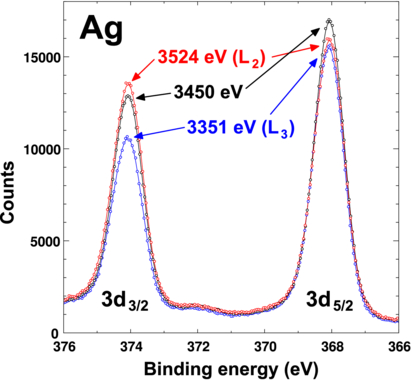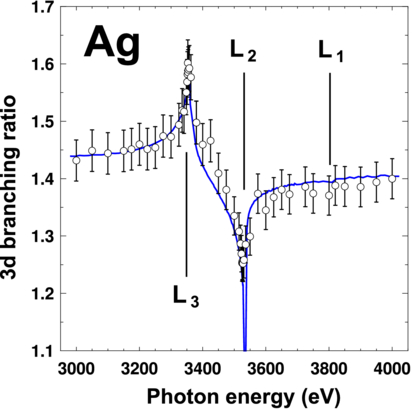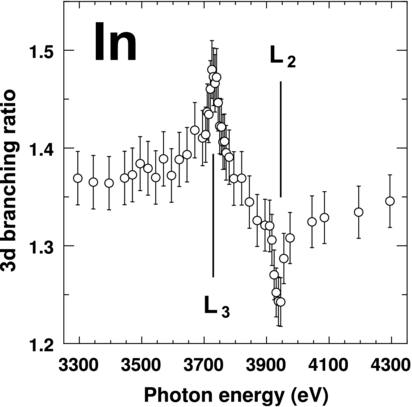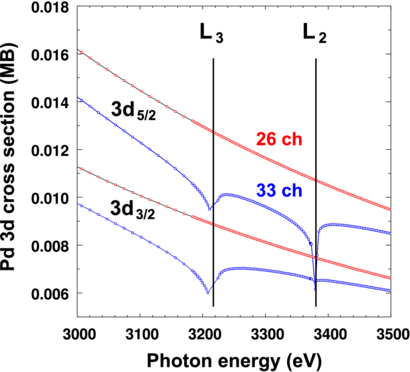Abstract
The 3d core level photoemission of metallic Ag and In was measured over a wide energy range including the 2p ionization thresholds. The intensities (photoionization cross sections) of the 3d5/2 and 3d3/2 lines were observed to modulate significantly with photon energy, both absolute and relative, and this is most pronounced in the vicinity of the 2p thresholds, i.e., at photon energies about an order of magnitude above the 3d thresholds. Calculations based on the relativistic-random-phase approximation show that this effect is due to interchannel coupling of the 3d photoionization channels with the 2p channels affecting the cross section over a wide range of energies. It is argued that this is a general phenomenon in high-energy photoionization throughout the periodic table.
Export citation and abstract BibTeX RIS
1. Introduction
Photoionization is a basic process of nature, in addition to having applications to a multitude of areas of science and technology. This, plus the advances in photon sources—both accelerator-based and table-top lasers—as well as detectors, along with computational power, has led to a significant increase in both experimental and theoretical studies of photoionization in recent years [1]. The great majority of these studies have been at low photon energies, less than 100 eV [1–5], where the photoabsorption is by outer and near-outer shells of the target and electron–electron correlation in its many forms is crucial to quantitative and qualitative accuracy.
For much higher energies, it had been generally assumed that subshell photoionization cross sections, far above their thresholds, are dominated by single-particle behaviour, especially for deep inner shells, particularly at keV photon energies [6, 7]. This energy range is the working ground of hard x-ray photoelectron spectroscopy, a technique which is becoming increasingly popular [8, 9]. Of course, it was known for some time that the photoionization of inner shells, even deep inner shells, is strongly affected by correlation near their thresholds; see, for example, [10]. However, it was only in 1997 that it was demonstrated that, for outer and near-outer shells the single particle approximation often breaks down well above threshold, owing to electron–electron correlation in the form of interchannel coupling, configuration interaction in the final (continuum) state of the photoionization process [11]. Briefly, when there is more than one photoionization channel at a given photon energy, this configuration interaction can substantially affect the channel with the smaller cross section by mixing in some of the channel(s) with the larger cross section. This has been demonstrated for subshell cross sections hundreds of eV above their thresholds in a number of cases, where calculations including interchannel coupling showed pronounced changes in magnitude and agreed with experiment significantly better than calculations omitting interchannel coupling [11–13]. In addition, several purely theoretical studies [14, 15] predicted significant changes in photoelectron angular distribution parameters, both dipole and nondipole, owing to interchannel coupling well above threshold in the keV region. We emphasize that in all of these cases, the primary effect of the interchannel coupling was to alter the magnitude of a subshell cross section at energies very far above its threshold.
What distinguishes the present investigation from these others is the fact that the interchannel coupling induces nonresonant structures in various subshell cross sections at energies very far above their thresholds. This nonresonant effect is not connected to the Rydberg resonances that lie below each inner-shell ionization threshold over a region of several eV; these structures are of the order of 50 eV wide. A hint of such a structure in Ne valence-shell photoionization in the vicinity of the K-shell was, however, seen earlier [11] but not noted; more recently, the same structure was found theoretically in Ne, and significantly larger structures were predicted in Ne@C60, Ne confined in a C60 molecule [16].
The present paper presents a combined experimental and theoretical study of this effect, i.e. interchannel-coupling induced structure well above threshold, an effect that should be present in many cases and is, thus, of general interest. In addition, the interchannel coupling is demonstrated in a much higher energy range, ≈3 keV above the threshold and for deep inner shells bound by ≈350 eV. Specifically, the photoionization cross sections of the 3d subshells of solid Ag and In were studied experimentally over a wide energy range including the region of the 2p thresholds. Calculations were performed on an adjacent atom in the periodic table, Pd, since a closed-shell system is much simpler to deal with theoretically, and, at energies several keV above threshold, the results should be rather insensitive to a small change of Z. Experimentally, Ag and In were chosen instead of Pd to stay clear of interfering L-shell Auger cascades in the kinetic energy range of interest [17].
2. Experimental methodology
The photoemission data were obtained using synchrotron radiation sources at Deutsches Elektronen-Synchrotron DESY (Hamburg, Germany). The Ag measurements were carried out at x-ray wiggler beamline BW2 of the DORIS III storage ring [18]. X-rays were monochromatized by a non-dispersive Si(111) double-crystal arrangement, the spectral bandpass varied from 0.5 eV at 3000 eV to 0.6 eV at 4000 eV. Photoelectrons emitted normal to the sample surface in the plane of photon polarization at 135° relative to the photon wave vector were measured by a hemispherical electron analyser (SCIENTA SES-200) with the resolution set to 0.2 eV. A high purity Ag metal foil was used as sample.
For an accurate normalization to the photon flux, the 2p3/2 photoelectron yield of Cu (cleaned high-purity foil mounted next to the Ag sample) was measured as an independent intensity reference for each photon energy, both before and after the Ag measurement to detect even small count rate variations in the electron spectrometer which may occur due to subtle x-ray beam position variations. Cu was chosen as a reference material because it exhibits no absorption edge structure in the photon energy range under study. Both metals were cleaned in situ by Ar ion sputtering. No attempt was made to normalize the measured spectra to the Cu photoionization cross section or the analyser transmission. For direct comparison with theory, the calculated values were instead normalized to account for the smooth energy dependence of the Cu photoionization cross section (see below).
An analogous experiment on metallic In was performed at x-ray undulator beamline P09 of PETRA III [19]. Here, photoelectrons were measured using a SPECS Phoibos 225HV analyser in the plane of photon polarization at 90° relative to the photon wave vector. The sample was illuminated at near grazing incidence angle, i.e., the electron emission angle was close to the surface normal, as in the case of Ag above. The total energy resolution in this experiment was 0.5 eV. Due to instrumental constraints an independent intensity signal from a reference material could not be accurately measured in this case.
3. Theoretical methodology
The calculation requires both the relativistic (spin–orbit) separation of the 3dj thresholds and the j-dependent dynamics of the 3dj cross sections, along with interchannel coupling, to describe the situation realistically. The relativistic-random-phase approximation (RRPA) is an ideal choice for this purpose. The details of the RRPA are well-documented elsewhere [20, 21]. Briefly, RRPA is based upon the Dirac equation, thereby including the j-dependent effects in an ab initio manner. In addition, RRPA starts with Dirac–Fock wave functions and includes significant initial state correlation [20, 21]. More importantly, for present purposes, RRPA includes interchannel coupling. Furthermore, RRPA allows for the possibility of truncation, i.e., performing the calculation with some of the photoionization channels omitted; this allows us to pinpoint the specific aspect of interchannel coupling causing a given effect.
Note also that RRPA is applicable only to closed subshell systems. For reasons explained above, the experiment was done for Ag (Z = 47) and In (Z = 49) which are open-shell systems and the calculation was performed for Pd (Z = 46), a closed subshell system with ground-state structure 1s22s22p63s23p63d104s24p64d10. However, for deep inner shells, this small change of Z should not matter much, except for small changes in threshold energies. This is because the change in charge represents only about a 2% change in the central potential, and the details of what goes on in the outer shells are quite irrelevant to photoionization at 3.5 keV.
The RRPA calculation for the Pd 3dj cross sections was performed coupling all relativistic single-photoionization channels from 2s, 2p, 3s, 3p, 3d, 4s, 4p and 4d subshells, a total of 33 coupled channels; the 1s was omitted since its threshold is at so high an energy (≈24 keV) that its inclusion could have no effects here. Specifically, the 33 channels that are included are:

In addition, the calculation was performed omitting the 2s and 2p channels, a 26-channel calculation. Comparison of the results of the two calculations allows us to spotlight the effect(s) of the coupling with the 2s and 2p channels on the 3dj cross sections.
4. Results and discussion
Typical Ag 3d core level spectra for photon energies around the L2, 3 thresholds are shown in figure 1. The intensities are accurately normalized to the photon flux as monitored by the photoelectron yield of a reference Cu 2p3/2 line, measured separately before and after each Ag 3d spectrum in order to account for any intensity changes of the primary x-ray beam or due to subtle x-ray beam position movements relative to the acceptance volume of the electron spectrometer. It is obvious that the intensity of the 3d5/2 and 3d3/2 lines changes significantly with photon energy, both in absolute as well as relative terms. This photon energy dependence of the peak intensities was measured over a broad energy range around the L thresholds from 3 to 4 keV and normalized to the independently recorded Cu 2p3/2 signal. The resulting data (fitted peak areas) are shown in figure 2. They track the energy dependence of the Ag 3d5/2 and 3d3/2 photoionization cross sections, normalized to the structureless Cu 2p3/2 cross section. The outstanding feature of these cross sections is the pronounced structure in the 3dj cross sections in the vicinity of the 2p thresholds, more than 3 keV above the 3d thresholds. These structures are 50 eV wide, and span energies from below to above the 2p thresholds, so they cannot be associated with the autoionizing resonances leading up to the 2p thresholds which extend, in any case, over an energy region of just a few eV [22, 23]. In addition, the slopes of the 3dj cross sections above and below the 2p thresholds exhibit a dramatic change. This does not correspond to single-particle model behaviour. To understand this phenomenology, the relative experimental cross sections measured in the plane of the photon beam direction at 45° to the polarization direction (i.e. 135° relative to the photon wave vector) are compared to the calculated Pd 3dj cross sections which are also shown in figure 2. These are the results of ab initio calculations except that the thresholds have been adjusted to match the experimental Ag thresholds. In addition, for direct comparison with the experimental data, the calculated values were also normalized by the energy dependence of the Cu 2p3/2 cross section interpolated from tabulated values [24]. The relative experimental cross sections have been scaled to the theoretical results at a single energy. Furthermore, to take into account that the experimental cross sections were measured at 45° to the polarization direction, the theoretical dipole photoelectron angular distribution parameters, β, were also calculated, and it is the β-adjusted theoretical cross sections that are shown in figure 2. The comparison between experiment and theory exhibits excellent agreement, both qualitatively and quantitatively. However, in the comparisons shown in figure 2, the experimental results are normalized to theory. To remove any possible inaccuracies due to the normalization, the ratio of the 3d5/2 cross section to the 3d3/2 (branching ratio) is shown in figure 3, along with the theoretical ratio, and the agreement between theory and experiment is excellent. Thus, it is abundantly clear that the RRPA calculation includes the specific aspect(s) of electron–electron correlation that results in the measured structures. The behaviour described above is also observed for other elements. Figure 4 shows the results of an analogous experiment for In, measured with another instrument under different geometrical conditions. Clearly, the peculiar relative cross section energy dependence of the 3d5/2 and 3d3/2 levels observed for Ag is reproduced for In, although the absolute values differ slightly.
Figure 1. Ag 3d core level spectra taken at photon energies corresponding to the L3 (3351 eV), L2 (3524 eV) thresholds and an intermediate value (3450 eV). The intensities are normalized to the photon flux as obtained from the corresponding Cu 2p3/2 photoemission yield.
Download figure:
Standard image High-resolution imageFigure 2. Experimental Ag 3d5/2 and 3d3/2 intensities (symbols) as a function of photon energy, normalized to a Cu 2p3/2 intensity reference measured for each energy point. The energy positions of the L-shell thresholds are indicated. The solid line represents the calculated photoelectric cross section of Pd, taking 33 channels into account. For comparison with the experimental data for Ag, the calculated values take into account the experimental geometry (β-adjusted cross sections) and were normalized to the (smooth) energy dependence of the Cu 2p3/2 cross section interpolated from tabulated values [24]. Also, the photon energies were scaled to match the Ag L2, 3 threshold energies.
Download figure:
Standard image High-resolution imageFigure 3. Measured Ag 3d5/2/3d3/2 branching ratio (symbols) as a function of photon energy; the energy positions of the L-shell thresholds are indicated. The solid line represents the calculated branching ratio for Pd 3d5/2/3d3/2, corrected for the experimental geometry and photon energies scaled to match the Ag L2, 3 threshold energies.
Download figure:
Standard image High-resolution imageFigure 4. Measured 3d5/2/3d3/2 branching ratio for In (symbols) as a function of photon energy; the energy positions of the L-shell thresholds are indicated.
Download figure:
Standard image High-resolution imageTo focus on the origin of this effect, a second RRPA calculation has been performed, a 26-channel calculation which is identical to the above 33-channel calculation except that the coupling of the higher channels with the 2p and 2s photoionization channels is omitted; the results of this 26-channel calculation is shown in figure 5 along the with the 33-channel result for comparison. It is quite evident that the 26-channel cross sections are smooth, structureless and exhibit no changes in slope. Thus, these features must be due to interchannel coupling of the 3d photoionization cross sections with the 2pj channels. Note also that, in addition to the structure, the background 3d cross sections are decreased by the interchannel coupling by ≈15%. These effects of interchannel coupling are specific cases of a more general feature of photoionization cross sections well above threshold; namely, that when a small cross section is degenerate with a large one, interchannel coupling mixes the final-state wave functions so that a small fraction of the large cross section is mixed with the small one, and vice versa. If the large cross section is really much larger, then mixing even a small fraction with the smaller cross section can materially alter the smaller cross section, i.e. increasing or decreasing it. In the present case the RRPA calculation shows that, in the vicinity of the 2p thresholds, the 2p cross section is more than an order of magnitude larger than the 3d; thus mixing of a small amount of the 2p cross sections with the 3d causes the 3d to take on some of the character of the 2p cross sections, which causes the phenomenology seen. Note that, since the 2p cross sections dominate all other subshell cross sections in the vicinity of the 2p thresholds, the mixing of the final-state wave functions for the 2p photoionization channels with a small amount of the 3d channel wave functions has virtually no effect on the 2p cross sections in the vicinity of the 2p thresholds.
Figure 5. Calculated partial photoionization cross section for Pd 3d5/2 and 3d3/2 including 26 and 33 coupled dipole channels, the latter including the Pd L-shell. Note that coupling to the L-shell introduces characteristic modulation of the 3d cross section in the vicinity of the L-shell thresholds, in very good agreement with the experimental data.
Download figure:
Standard image High-resolution imageNow, there is nothing particularly special about Pd, Ag or In, so this should be a general phenomenon throughout the periodic table. This is also suggested by the fact that excellent agreement is obtained with the experiment on one element (Ag) and the calculation on the adjacent element (Pd). The details might differ in different regions of the periodic table, but the effects of interchannel coupling of deep inner shells on the photoionization of higher atomic shells should persist.
Finally, note that the Thomas–Reiche–Kuhn sum rule [25], i.e., the sum over the oscillator strengths of all discrete and continuum transitions from an atom equals the number of electrons, is essentially exact. In addition, within a central-potential model, the sum rule holds exactly for each individual subshell. But, it has been noted experimentally that while this is roughly true subshell by subshell [26, 27], it is certainly not exact. Interchannel coupling is an important contributor to the deviation from exactness; the present case (figure 5) shows quite clearly that the 3d cross section (and, thus, the oscillator strength) is lowered by more than 10% by the interchannel coupling. Clearly then, the total oscillator strength from individual subshells should not be expected to be exactly the number of electrons, and the deviation is likely related to the strength of the interchannel coupling in the system.
5. Concluding remarks
In conclusion, broad structures are found experimentally in the 3d photoionization cross section of metallic Ag and In in the vicinity of the 2p thresholds, i.e., at photon energies about an order of magnitude above the 3d thresholds. Theoretical calculations show that these structures are not resonances, and that this phenomenon is due to interchannel coupling of the 3d photoionization channels with the 2p channels. The independent particle approximation which had been thought to be applicable to atomic photoionization cross sections well above threshold is clearly not applicable. Specifically, it is not applicable to channels with small cross sections that are degenerate with channels with large cross section. It is always the case that deep inner-shell cross sections near their thresholds are much larger than the cross sections of higher shells in that energy region. Not only are structures induced by interchannel coupling, but the magnitude of the cross section over a wide range of energies is shown by theory to be affected, likely changing the total oscillator strength from individual subshells. While the overall magnitude change has been noted previously, along with a few cases of induced structure, this is the first systematic combined theoretical and experimental observation of pronounced structures having nothing to do with resonances. Finally, this should be a general phenomenon for high-energy photoionization throughout the periodic table. These findings are particularly relevant for quantitative analyses of hard x-ray photoemission data for shallow levels if the excitation energy is in the vicinity of deep core level thresholds of the same atom.
Acknowledgments
The authors thank Th Eickhoff for help during the experiment at BW2 and T Åberg for helpful notes on the theoretical situation. The HAXPES instrument at beamline P09 is jointly operated by the University of Würzburg (R Claessen), the University of Mainz (C Felser) and DESY. Funding by the Federal Ministry of Education and Research (BMBF) under contracts 05KS7UM1, 05K10UMA, 05KS7WW3, and 05K10WW1 is gratefully acknowledged. STM acknowledges funding by the US Department of Energy, Office of Basic Energy Sciences under grant DE-FG02-03ER15428.





